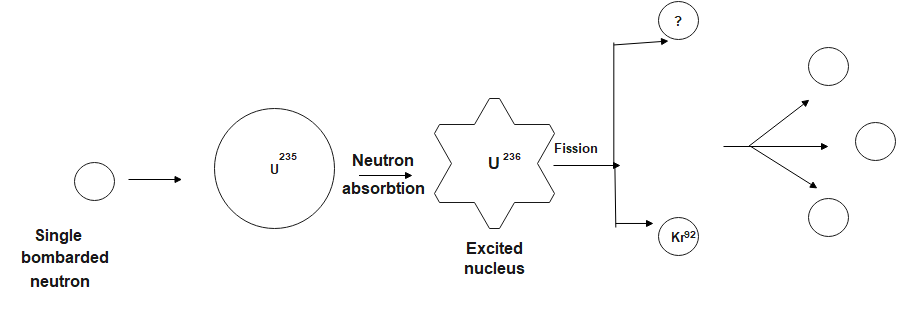Answer
394.8k+ views
Hint: The original uranium-235 nucleus absorbs a neutron, splits into a nucleus of krypton-92 and a nucleus of barium-141, and upon splitting, releases three more neutrons. Those three neutrons can then cause three more nuclei of uranium-235 to fission, each of which releases more neutrons, and so on.
Complete answer:
in two extremely unstable fission fragments, a barium and a krypton nucleus, one of the many known fission reactions of uranium-235 induced by absorbing a neutron result. Almost instantaneously, these fragments release three neutrons between them, becoming barium-144 and krypton-89. In turn, by repeated beta decay, barium-144 is gradually converted to other fission products, lanthanum-144, cerium-144, praseodymium-144, and ultimately relatively stable neodymium-144; and krypton-89 is similarly transformed by rubidium-89 and strontium-89 into stable yttrium-89. The chemical properties and radioactive properties of fission products, such as their half-lives and the kinds of particles they emit, are identified by fission products.
The fission reaction is:
${ }^{236} \mathrm{U} \rightarrow{ }^{92 \mathrm{Kr}}+{ }^{\mathrm{A}} \mathrm{X}$
In a nuclear reaction, the net mass number of the reactant must be equal to that of the product. $\therefore 236=92+\mathrm{~A}$
$\text{A=144}$
Thus, the element detected: Barium – 144
The correct option is (A).
Additional Information:
Typically, elements such as krypton, strontium, caesium and barium are the fission products. The problem is that the radioactive isotopes of these elements are produced by nuclear fission. These radioactive isotopes will decay and give out ionizing radiation as they do so in the normal manner.
Note:
Due to their abnormally large number of neutrons compared to protons, the fission fragments are highly unstable; therefore, they undergo successive radioactive decays by emitting neutrons, converting neutrons into protons, antineutrinos, and ejected electrons (beta decay), and radiating energy (gamma decay).
Complete answer:
in two extremely unstable fission fragments, a barium and a krypton nucleus, one of the many known fission reactions of uranium-235 induced by absorbing a neutron result. Almost instantaneously, these fragments release three neutrons between them, becoming barium-144 and krypton-89. In turn, by repeated beta decay, barium-144 is gradually converted to other fission products, lanthanum-144, cerium-144, praseodymium-144, and ultimately relatively stable neodymium-144; and krypton-89 is similarly transformed by rubidium-89 and strontium-89 into stable yttrium-89. The chemical properties and radioactive properties of fission products, such as their half-lives and the kinds of particles they emit, are identified by fission products.
The fission reaction is:
${ }^{236} \mathrm{U} \rightarrow{ }^{92 \mathrm{Kr}}+{ }^{\mathrm{A}} \mathrm{X}$
In a nuclear reaction, the net mass number of the reactant must be equal to that of the product. $\therefore 236=92+\mathrm{~A}$
$\text{A=144}$
Thus, the element detected: Barium – 144
The correct option is (A).
Additional Information:
Typically, elements such as krypton, strontium, caesium and barium are the fission products. The problem is that the radioactive isotopes of these elements are produced by nuclear fission. These radioactive isotopes will decay and give out ionizing radiation as they do so in the normal manner.
Note:
Due to their abnormally large number of neutrons compared to protons, the fission fragments are highly unstable; therefore, they undergo successive radioactive decays by emitting neutrons, converting neutrons into protons, antineutrinos, and ejected electrons (beta decay), and radiating energy (gamma decay).
Recently Updated Pages
What are examples of protein polymers class 11 biology CBSE

What are examples of primary producers A Omnivores class 11 biology CBSE

What are examples of peripheral vascular disease class 11 biology CBSE

What are examples of monosaccharides and polysacch class 11 biology CBSE

What are examples of Gastropods class 11 biology CBSE

How are even small animals important in an ecosyst class 11 biology CBSE

Trending doubts
Which of the following is the most stable ecosystem class 12 biology CBSE

Which are the Top 10 Largest Countries of the World?

Difference Between Plant Cell and Animal Cell

Which of the following is the most stable ecosystem class 12 biology CBSE

Write an application to the principal requesting five class 10 english CBSE

Difference between Prokaryotic cell and Eukaryotic class 11 biology CBSE

Give 10 examples for herbs , shrubs , climbers , creepers

Write a letter to the principal requesting him to grant class 10 english CBSE

The term vaccine was introduced by A Jenner B Koch class 12 biology CBSE




